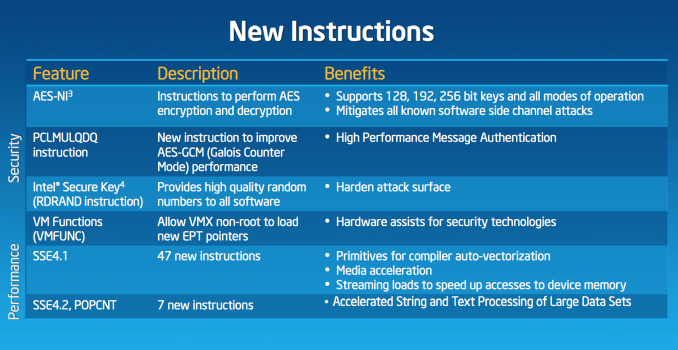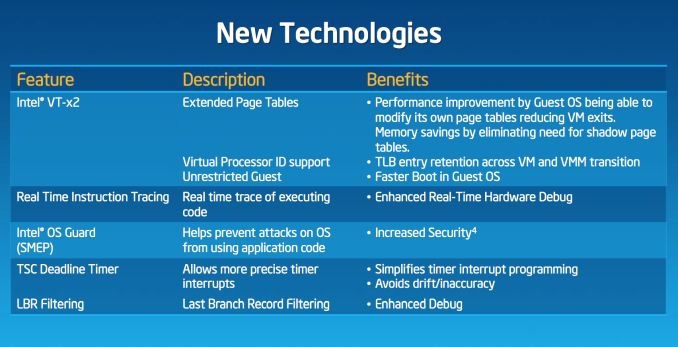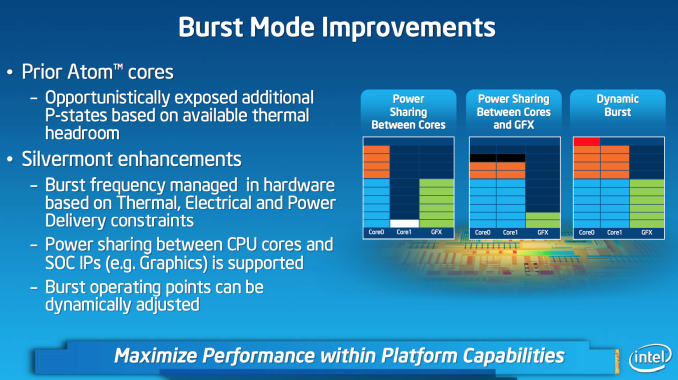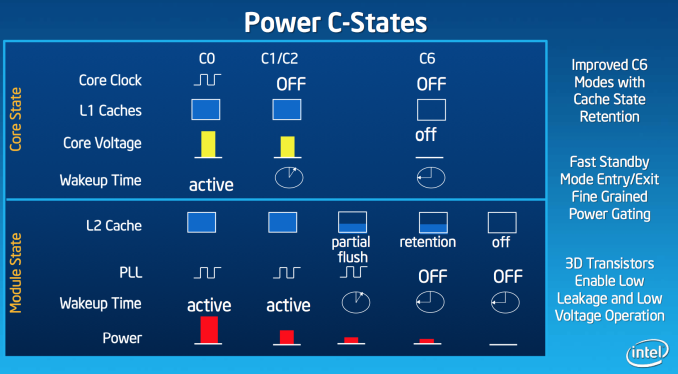Intel’s Silvermont Architecture Revealed: Getting Serious About Mobile
by Anand Lal Shimpi on May 6, 2013 1:00 PM EST- Posted in
- CPUs
- Intel
- Silvermont
- SoCs
ISA
The original Atom processor enabled support for Merom/Conroe-class x86 instructions, it lacked SSE4 support due to die/power constraints; that was at 45nm, at 22nm there’s room for improvement. Silvermont brings ISA compatibility up to Westmere levels (Intel’s 2010 Core microprocessor architecture). There’s now support for SSE4.1, SSE4.2, POPCNT and AES-NI.
Silvermont is 64-bit capable, although it is up to Intel to enable 64-bit support on various SKUs similar to what we’ve seen with Atom thus far.
IPC and Frequency
The combination of everything Intel is doing on the IPC front give it, according to Intel, roughly the same single threaded performance as ARM’s Cortex A15. We’ve already established that the Cortex A15 is quite good, but here’s where Silvermont has a chance to pull ahead. We already established that Intel’s 22nm process can give it anywhere from a 18 - 37% performance uplift at the same power consumption. IPC scaling gives Silvermont stable footing, but the ability to run at considerably higher frequencies without drawing more power is what puts it over the top.
Intel isn’t talking about frequencies at this point, but I’ve heard numbers around 2 - 2.4GHz thrown around a lot. Compared to the 1.6 - 2GHz range we currently have with Bonnell based silicon, you can see how the performance story gets serious quickly. Intel is talking about a 50% improvement in IPC at the core, combine that with a 30% improvement in frequency without any power impact and you’re now at 83% better performance potentially with no power penalty. There are other advantages at the SoC level that once factored in drive things even further.
Real Turbo Modes & Power Management
Previous Atom based mobile SoCs had a very crude version of Intel’s Turbo Boost. The CPU would expose all of its available P-states to the OS and as it became thermally limited, Intel would clamp the max P-state it would expose to the OS. Everything was OS-driven and previous designs weren’t able to capitalize on unused thermal budget elsewhere in the SoC to drive up frequency in active parts of chip. This lack of flexibility even impacted the SoC at the CPU core level. When running a single threaded app, Medfield/Clover Trail/et al couldn’t take thermal budget freed up by the idle core and use it to drive the frequency of the active core. Previous Atom implementations were basically somewhere in the pre-Nehalem era of thermal/boost management. From what I’ve seen, this is also how a lot of the present day ARM architectures work as well. At best, they vary what operating states they expose to the OS and clamp max frequency depending on thermals. To the best of my knowledge, none of the SoC vendors today actively implement modern big-core-Intel-like frequency management. Silvermont fixes this.
Silvermont, like Nehalem and the architectures that followed, gets its own power control unit that monitors thermals and handles dynamic allocation of power budget to various blocks within the SoC. If I understand this correctly, Silvermont should expose a maximum base frequency to the OS but depending on instruction mix and available TDP it can turbo up beyond that maximum frequency as long as it doesn’t exceed TDP. Like Sandy Bridge, Silvermont will even be able to exceed TDP for a short period of time if the package temperature is low enough to allow it. Finally, Silvermont’s turbo can also work across IP blocks: power budget allocated to the GPU can be transferred to the CPU cores (and vice versa).
By big-core standards (especially compared to Haswell), Silvermont’s turbo isn’t all that impressive but compared to how things are currently handled in the mobile space this should be a huge step forward.
On the power management side, getting in and out of C6 should be a bit quicker. There's also a new C6 mode with cache state retention.















174 Comments
View All Comments
Ortanon - Monday, May 6, 2013 - link
This.jamesb2147 - Monday, May 6, 2013 - link
That's not an excuse for subjective fluff. Don't get me wrong, I particularly liked the Bulldozer performance reviews and analysis. The reason I liked them was the hard data used to develop ideas about possible use-case scenarios for the CPU's. This article is full of "IT'S GONNA BE AWESUMMMMMM!!!!!1!!!" and not so much nuanced, objective reporting on actual news. It has plenty of analysis, but without concrete evidence, it reads like one of those all-too-familiar forum rants from HardForum or the like, full of people with too much time and not enough to do.If Anandtech is evolving into one of those news outlets that has to keep writing articles to keep people engaged, then I'm not interested. And it's not just my loss, it's the readership's.
wsw1982 - Tuesday, May 7, 2013 - link
if the clover trail+ already has similar performance as the best ARM offer, and the silvermont is said to be 2 times better than clover trail+. What should be the most logic sentiment in your opinion?phoenix_rizzen - Tuesday, May 7, 2013 - link
Well, you're comparing some future Intel SoC that no one has been allowed to actually touch/test (using only Intel's internal "benchmarking") against currently available ARM SoCs. Who knows what the performance will be like for ARM SoCs in 8-12 months, when these Intel SoCs are actually, physically able to be benchmarked.Cautious optimism is warranted. Not flat-out "OMG, THIS IS THE BESTEST EVAR!" fluff like this article spouts.
Spunjji - Wednesday, May 8, 2013 - link
Restrained optimism and a desire for further evidence. I can only assume Anand has already seen more than us, as his attitude is somewhat more positive than that. If he hasn't, well, I have expressed the opinion before that I find he treats Intel press releases rather lightly.cjb110 - Tuesday, May 7, 2013 - link
tbh that's an OTT response, AnandTech have done a piece based on the info they have and their previous experience. Everything mentioned is reasoned out in a logical progression. You might not always agree with the reasoning but its most certainly isn't 'fluff'. There will be a data based analysis later, as always.Krysto - Monday, May 6, 2013 - link
But not entirely unbiased. Making a detailed analysis and being biased aren't mutually exclusive.Krysto - Monday, May 6, 2013 - link
See asymco.com (apple fanboi doing "indepth analysis" about Android and other competitors.. Guess what? They usually favor Apple).Homeles - Monday, May 6, 2013 - link
I doubt there's a single human being on the face of the planet that is unbiased. What's your point?Thrill92 - Tuesday, May 7, 2013 - link
Oh no, your going to have to do some critical thinking about the data and conclusions in media. What ever will you do?